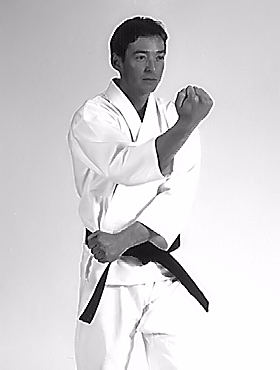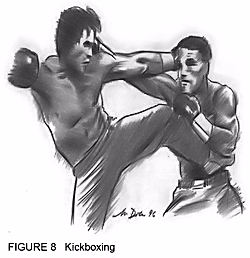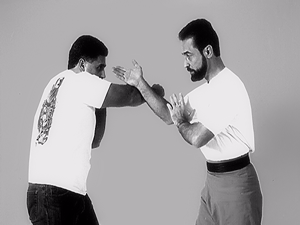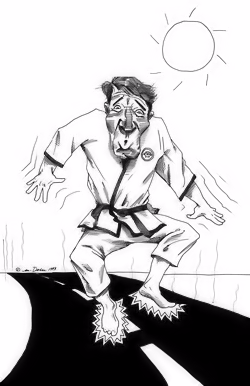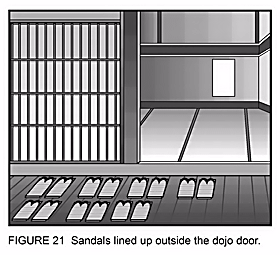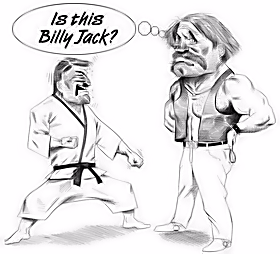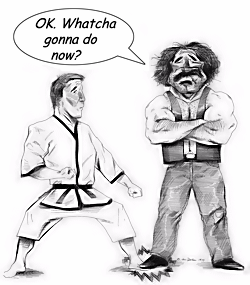
In karate there comes a time when the orderly progression of study brings you to the highest level – to spontaneity. You practice basic drills so that you can escape them. As you progress in the orderly practice of basics, and providing you stay with it long enough, one day you escape the practice and become spontaneous.
QWERTYRepetition and practice are, as George Anderson accurately observed (Beaver 1992,20), the keys that unlock the door to spontaneity. However, for spontaneity to be effective, those things that are repeated and practiced must themselves be based on sound principles. For example, practicing keyboard skills regularly will make you a better typist. Dedicated practice will make your fingers virtually fly across the keyboard. However, the standard keyboard arrangement – nicknamed QWERTY, for the first six letters on the top alphabetic row – was actually designed to slow the typist.  Type levers on early mechanical typewriters jammed with greater frequency as typists became faster. The QWERTY key layout solved this problem by placing the letters that occur most frequently (in the English language) in the most inaccessible positions. This resolved the problem of malfunctioning typewriters, but it did so at the expense of efficiency. Over time, mechanical typewriters improved. In the 1930s, electric typewriters appeared; in the 1960s, some machine designs replaced the type levers with a type-surfaced ball that moved across the paper (rather than moving the paper under the type). Newer typewriters replaced the type-ball with a plastic daisy wheel. Despite these evolutionary advances in typewriter design and capability, one essential element remains unchanged: the QWERTY keyboard. A more efficient keyboard arrangement was devised in 1936 by August Dvorak. With the Dvorak keyboard, the letters are arranged so that 70 percent of the typing takes place on the "home row." This and other Dvorak improvements mean that a skilled Dvorak typist can type at better than twice the speed of the best QWERTY typist. The Dvorak typist is more productive, not because he or she practices longer than the QWERTY-trained typist, but because the Dvorak keyboard is based on sound principles of keyboard design. The QWERTY illustration exemplifies this chapter's underlying principle: "Repetition and practice are the keys that unlock the door to spontaneity. However, for spontaneity to be effective, those things that are repeated and practiced must themselves be based on sound principles." With this maxim in mind, let's look at our first example of classical training and one that is as fundamental to martial arts as keyboards are to typewriters: namely, punching and blocking.
Punching and Blocking TheoryEarly in my training I observed that the greatest weakness in classical Asian martial arts is the way they teach basic punches and blocks. Most Asian martial art systems teach students to punch and block by extending the punching or blocking arm to the target while simultaneously cocking the other arm at the hip or side (figures 2 and 3). I emphasize the word "teach" here because experience shows that what is taught, and what students of Asian arts actually use when fighting, are two very different things. Classical Punching
There is no disputing the power claims made by proponents of the classical method. Indeed, coupled with proper hip rotation, punches delivered this way are powerful. However, punches fired from the hip, though powerful, are simply too slow. This is because they have too great a distance to cover before reaching the target. Here's what I mean. Given equal speed, which punch will hit its target first: the one traveling the thirty-five or thirty-six inches from the hip to the opponent's face (figure 4), or the one traveling twenty-five inches (figure 5)? The answer is obvious. Before anyone jumps higher than his blood pressure and begins shouting how much more powerful the thirty-five-inch punch is than the twenty-five-incher, consider this: with proper hip and shoulder rotation (shoulder rotation in punching is not usually emphasized in the more popular Asian martial arts), ... with proper hip and shoulder rotation, even an eighteen-inch punch will put a man down decisively. They do this in boxing all the time – and with gloves on, no less. But evaluating the effectiveness of punching methods involves another factor: the targets.
Long-armed, thirty-inch-plus corkscrew punches were designed to smash through rigid body armor – and they did their jobs well. Fortunately for the student training to survive in today's environment, his foes are not clad in rigid armor (kevlar, perhaps, but not sixteenth century Japanese toshi-gusoku armor). Knowing that your classical punches can "crack the turtle's shell"1 is comforting only until you run into an opponent who is skilled enough to avoid them. Beyond the lack-of-speed problem, the classical punching method has another disadvantage: vulnerability. Punching with the counter hand chambered at the hip not only slows your punch (because of its distance from the target), it also creates a mammoth opening in your defense. An opening of this magnitude gives your adversary easy access to such prime targets as your ribs, solar plexus, and sternum. Even if you accept the claim that classical punches are stronger, more power at the expense of one's ribs seems a very poor trade. The classical long-armed corkscrew punch may work well against a board or brick or an unskilled opponent, but against today's quicker, better-trained fighters, it fails – painfully. Classical Blocking One writer favoring the classical method, suggested that if your block fails to do the job of saving your face, then perhaps the problem is not with the effectiveness of the technique but with your execution or timing of the movement (Lowry 1992, 108). As justification for this position he recounted how some master during World War II dispatched an attacker with a block so powerful that it literally bowled over his hapless assailant. I cannot dispute the truth of his tale since I was not there to witness the event (and neither was the writer). Moreover, his account of the incident does not include any relevant specifics and circumstances of the attack. (In fairness, the writer would have been hard pressed to share this information in his short column. Nevertheless, we are still left without any hint, for example, of how skilled the master's assailant was, how large or small he was, or any other circumstances that might explain the reported outcome.)
Further, even if the story is true, for every account of one master's success, there are dozens of other real-life reports of dismal failure. What is even more surprising is that many examples of this kind of "loss of face" come from the experiences of black belts who have had their clocks cleaned by students of Western boxing. Doubtless, some defenses do fail because of poor execution, but an overwhelming number of them fail because the underlying theory, like the QWERTY keyboard arrangement, is flawed.
Hand Skills — Karate Vs. BoxingIn classical karate, the punches – fired from the hips – are long, and the blocking philosophy is based primarily on deflecting and redirecting the assailant's attack. In boxing, the punches – coming largely from the shoulder – are shorter, and the blocking philosophy is largely one of absorbing the opponent's blows, usually by taking them on the arms.2 On the surface, against skilled opponents, boxing hand skills appear superior to those found in classical Asian arts, and from a strictly striking perspective, they are. Boxing has a limited, but highly refined and very effective suite of punching techniques and tactics. However, from an overall self-defense perspective, boxing's blocking methods are limited and otherwise impractical for all but a handful of young, hardened practitioners.3The problem is that, although boxing is excellent for self-defense, it is practiced largely as sport, and its sport trappings are what detract from its combat effectiveness. The biggest of these detractions is the use of padded gloves. This is significant because, from a blocking perspective, the desirability of absorbing punches on the arms evaporates once the gloves are removed. Replacing outdated classical Asian blocking methods with those from Western boxing is, for most of us, then, not the answer. But if not the Western boxer's methods, whose? There is, yet, another option. Another Option Multihand4 combination blocks and strikes provide better protection from the initial assault because, as with the Western boxing method, both hands are kept between the practitioner and his opponent. However, unlike the boxer's technique, multihand combinations – reflecting their Asian origins – rely on deflection rather than absorption to neutralize the attack. When intercepting incoming blows, the defender utilizing multihand combination keeps his hands open, relaxed, and constantly in the field of play. This, coupled with the fact that his hands do not chamber before blocking or striking, means that the hands are much, much quicker to their targets. It is important to remember here that the benefits of this method exceed those promised by the classical method because multihand combination blocks and strikes are based on sound principles. Equally important, as you will see, is the fact that these combinations are executed exactly as they are practiced. And, as if adding icing to the cake, their practice is both challenging and enjoyable. The following fictitious conversation between the sage martial art teacher and his American pupil illustrates why that last point is important.
Serious Fun? An alternate method of training, and one that teaches multihand blocks and strikes in a challenging and stimulating way, utilizes a basic two-man drill like the Filipino hubud. Parroting the hubud drill, multihand training exercises are two-man continuous sets that develop combination-type reactions to an opponent's punches. They develop the skills necessary to thwart a variety of hand attacks. Moreover, they allow both partners to act and react continuously to each other's punches and strikes, developing a flexibility and spontaneity in the practitioners that enables them to adapt to the rapidly changing dynamics of a fight. The continuous nature of a two-man multihand drill allows both partners to sustain practice for an extended period, thereby accumulating many more repetitions than they would with, for example, any of the traditional methods mentioned above. Nonstop repetition allows each student to monitor and correct his errors with each successive iteration, getting the feel of doing it right. (In this kind of practice, the feel of the attack is much more important than the visual perception, because in most real confrontations your ability to see clearly is often reduced.) As a rule, most training methods teach principles of movement rather than actual technique. However, the beauty of the training drill you are about to see – and this is only one of a number of similar drills – is that it does both. It teaches sound principles of movement and, simultaneously, real self-defense technique. As you move through this very basic four-count drill, keep in mind that the first two counts represent the blocking portion and counts three and four the striking part. Although it is possible to separate them, one should do so with care. You see, as a training vehicle, it is the drill's continuous nature that makes the practice of basic blocking and punching fun. Practice that is fun gets more use, and "more use" results in a more effective martial artist. Isolate the components of the drill to understand them, but remember that the real value of the individual components as arranged in this drill lies in their synergistic combination. A Basic Drill
Counts one and two are followed immediately by player-B's already positioned left hand slapping down his opponent's right arm (figure 11). Some may think that this third count clears or checks player-A's arm, but as you will see, it does much more than that. But let's recap what has just taken place. So far in our drill, player-A has punched with his right and player-B has responded as follows:
Figure 11 (the third count) begins the striking portion of the drill. The downward slap does, indeed, clear player-A's right arm. More importantly, it also pulls A's face into B's right counterpunch (figure 12). Notice that as player-B fires off his right punch, player-A intercepts it with his left hand, to begin his four-count iteration of the drill. As a drill, this sequence is routinely practiced in a way that keeps both players outside their partners' punches; however, this is not an absolute requirement. It just makes the back-and-forth action of the drill easier to sustain. In reality, the movement is equally effective when applied inside a punch, and against either left or right blows. But back for a moment to the third count in this drill: the one that pulls the opponent into the defender's counterpunch. Some may feel that this multihand method lacks any real power because the hips are not used in delivering the blow. They are partly correct. The hips do not drive the punches. However, the third movement, when executed simultaneously with the fourth (the final strike), actually accelerates the opponent's face into the defender's right punch, resulting in a "head-on" collision of sorts. Does this guarantee a knockout? No, but few punches do. Even under the best circumstances, the energy you actually transmit to a target with a punch – or any blow for that matter – is always less than optimal, for any number of reasons. This is especially true when striking the head because it is one target that very naturally yields to forces directed against it. Any technique, then, that can simultaneously direct and accelerate this very flexible target into a blow, gains a significant increase in impact. As such, it more than makes up for the lack of hip rotation in its delivery. The Obvious Obscured As the right hand moves right-to-left across your lower torso, the left hand moves inward, across your chest, left-to-right (much like a classical close-to-the-vest left inward block). Some explain this simultaneous movement of the left and right hands as a "windup" for the right outward (left-to-right) block that immediately follows. The windup explanation may be valid and it is certainly taught this way in many martial art schools, but it looks amazingly similar to the first two counts of the multihand drill. Figures 13 and 14 provide a comparison.
Is the multihand block an extension of the classical maneuver – or is it the forerunner? The similarities are much too close for mere coincidence. Writer Chris Thomas, in describing the differences in the various Okinawan karate arts, pointed out that one of the obvious changes Chojun Miyagi made in the development of his goju-ryu karate was the replacement of many open-hand moves with the closed fist (Thomas 1993, 39). Moreover, he reported that "this tendency to substitute fists for open-hand techniques is a common characteristic of Okinawan karate" and that such changes may have begun with naha-te founder Kanryo Higashionna, himself. If this is the case, then the open-hand method may actually be the predecessor to the clenched-fist method that today we call "classical." Many arts use open-hand blocks, and an equal number use closed fists; all of them mix both. The point is, we must look for more than just differences in training methods. We must also look for similarities and common principles of movement between arts – regardless of whether they are executed with clenched fists or open hands. Multihand combination blocks work best with open hands; however, if their principles are not clearly understood or practitioners simply do not feel comfortable with them, then their evolution to fists with "windups" before execution is understandable. Knowing this, it's possible to see how the practice with fists evolved. But let's continue our examination of the multihand movement and see how it fares against the trained contemporary fighter. Against a Boxer Considering the quickness and caliber of the trained boxer – or the seasoned street thug – the multihand, two-man, continuous-action training drill provides the student with defensive tools he can use quickly. That's the beauty of this training method. With just a few hours of practice, even a novice can block and strike with a high probability of success. I teach such drills to beginning students immediately – before I ever break down the drills into their block-right and block-left movements.7 You have just seen the drill as practiced against a single punch. It is substantially faster and more effective than the classical method because, as I pointed out before, it keeps both hands between you and your assailant. However, the drill really shines when the skills developed are used against multiple incoming blows – like those you would expect from a boxer (something against which the classical blocking method has some serious shortcomings). Against a basic left-right, one-two punch combination, the classical outward block might pick up the first punch, but because the defender has his other hand cocked at the hip and far from the action, the boxer stands a much better chance of crashing through with his second shot than the defender does of counterattacking with his own (figures 15 and 16).
Revisiting the same attack – this time with the defender using the multihand combination – we find the left parry (count one of the drill) intercepting the attacker's left jab – and the right hand that immediately follows the left (count two) quickly picking up the attacker's right (figures 17 and 18). The multihand approach is not, however, limited to handling only two blows. Since the drills are practiced with the players in constant motion, variables are easily introduced to condition and control the flow. With the hands always in motion, picking up additional punches becomes automatic. (Obviously, you cannot and should not expect to intercept every punch. At some point something other than blocking is necessary to discourage further attacks.) If the karate player's Western nemesis is the boxer, then these two-man drills are the practitioner's great equalizer. With time and practice, these drills also develop improved hand-eye coordination, quicker reflexes and reaction, better sensitivity to differing degrees of threat, and sophisticated hand skills that are more than a match for a boxer. It is my contention that in the evolution of Asian blocking and striking methods, something was lost. It may have been that Okinawans had different needs, or they lacked an appreciation of the open-hand method (the same might be said of us today). In any case, the result of all this is that many of those still practicing the classical methods do so out of habit, and without a thorough understanding of what they are doing. True to form, they follow the shell of the original movement, but without the substance. Multihand combination blocking, coupled with unchambered punches, returns the substance to a very basic and necessary skill. Let's now move to what I consider the number two problem in classical Asian martial art training – a problem that goes to the very "sole" of the art: the practice of training in bare feet.
Why Train in Bare Feet?
You might, if you really stretch it, raise the same concern over uniforms, noting that, most practitioners and students train in loose-fitting traditional garb. But is there really a tension between this practice, and potential application of martial skills in everyday apparel? Actually, no; for two reasons. First, because the benefit of training in loose-fitting clothes outweighs any lack of reality and, second, because the difference between martial art uniforms and everyday wear is comparatively insignificant. Training in loose-fitting clothes allows the student to flex and stretch muscles, and thereby exercise through a much greater range of motion than would be possible in a suit or dress – an obvious conditioning benefit. It is true that everyday attire is generally more restrictive than a typical martial art uniform, but kicking to the groin should still be possible even in tight blue jeans. (Anyone whose jeans are so tight that they can't raise their legs that high has a more serious problem than self-defense to deal with anyway.) In reality, any difference that exists between training in uniform and working in everyday wear, is insignificant when compared to the difference between training-in-bare feet and our modern work-a-day shoe-wearing activities. The uniform question is so weak as to be a nonissue. The next logical question ought to be, "Are there other benefits to barefoot training?" Also, "Are there any disadvantages to training in shoes?" Is it possible that kicking in shoes increases the risk of injury because the shoe is, obviously, harder than an unshod foot? Actually, no. Medical professionals suggest that the majority of martial-art-related injuries they see are foot and ankle injuries. Although incidents of strained, sprained, jammed, or broken toes makes up a large portion of these numbers, it is estimated that toe injuries are probably many times higher than what is reported. This is because few seek treatment for toe injuries – "after all," they reason, "it's only a toe." (Martial artists are often as long on toughness as they are short on common sense.) Training in shoes reduces these incidents drastically. But since the shoe is, in fact, harder than a bare foot, might we see an increase in other injuries, say, when sparring? Sparring is a special case, and one that I will address in detail shortly, but for now let me say that for all other types of training – especially since we're not advocating wearing cowboy boots or wingtips – the risk of injury from training in suitable sport shoes is far less than the risks currently realized by training in bare feet. A better question might be, "Are there other benefits to training in bare feet – like conditioning and callousing them?" With the possible exception of sparring, the answer is also, no – unless, of course, you spend most of your waking hours in bare feet. If I've overlooked some obvious benefit to training in bare feet, I apologize, but I see no reason, beyond those already stated, why we in the West should train barefooted. We could rehash this side of the issue forever, but that would put us no nearer the truth. Let's look, instead, at the origins of this now common training custom. Origins Other cultures and levels of society, although well acquainted with footwear, customarily removed their shoes, for example, when going indoors. Some cultures do this still. If, therefore, the training hall was indoors, then the training was (you guessed it) conducted in bare feet. This is one way cultural practices wend their way into martial art training, eventually becoming martial art traditions.
Having trained in bare feet for more than a decade before switching to training in shoes, I can say unequivocally that training in shoes is as different from training in bare feet as day is from night. Further, curling the toes inside a pair of hard-soled leather shoes is not easy, and I do not recommend even trying to do so. Kicking with the blade of the foot is also a poor idea. Against a hard target, it is a sure ankle buster. Moreover, when executing spinning heel and hook kicks in shoes, the foot and heel are definitely held in a different position (the foot is extended, the toes are pointed, and the strike is routinely made with the bottom of the foot). Training in shoes is, in fact, so different from training in bare feet that most kicking theories fly right out the window. How, then, do we rectify this? How do we train in shoes (for self-defense realism) and, at the same time, retain good form while insuring the safety of all the participants? Where do we begin and what practices must we observe or avoid? Let me show you what works for us.
A Practical, Shoes-On ApproachI joined the United States Marine Corps just eight years after the conclusion of the Korean War. While on active duty, I met many veterans of that "conflict" who fought alongside Turkish units (Turkey was a part of the United Nations force). Without exception, every marine I spoke with acknowledged the toughness and fighting skill of our Turkish allies. This was high praise from marines. Well, Turkish commandos (the best of their best) train extensively in Asian fighting arts. Visit their training camps and you will see them practicing many of the same punching and kicking drills we practice here. One thing is different, though – very different: they train in what they fight in. They train in combat fatigues and wearing heavy combat boots.
Simulation of Reality
Not to be forgotten are the medical reasons for training in shoes: good shoes greatly reduce wear and tear on the student. All-out "blitz" training (that is, practicing techniques that require an explosion out of the gate) and hard-hitting back and side kicks on a heavy bag are extremely stressful on the foot, knee, hip, and spine. Recognizing these hazards, martial artists have for years sought ways to prolong training without wearing out the their bodies. However, some of the solutions devised for this problem are absurd. For example, some schools install specially designed floors to reduce impact-related foot stress and strain (Lowry 1993, 126). (One school even installed thousands of small springs under the wood flooring!) All of this so that they can continue to train the traditional way. The motivation here is admirable, but the method is extreme. Altering the training surface to reduce or prevent barefoot-training injuries makes less about as much sense as softening the highways to smooth the ride for automobiles, trucks, and buses. Isn't this why automobile and tire manufacturers designed low-pressure rubber tires and fluid and gas shock absorbers? Instead of making the floor softer, isn't it smarter to simply have everyone wear clean, quality workout shoes? Certainly, it is a whale of a lot cheaper (not to mention warmer). Even when students are training on concrete floors (not something I recommend), proper shoes significantly reduce the stress that typical martial art training places on the all joints of the body, not just the feet. Slamming the human foot on the floor or into a heavy bag produces, literally, hundreds of pounds of pressure per square inch on the foot. The shock from this force is transmitted through all of the joints involved. Good training shoes provide a cushion for the heel and the ball of the foot that the unprotected foot does not naturally have. As such, they dramatically reduce physical wear and tear. Good training shoes, then, are a must for training longevity. (And think about it: the longer you can train, the better you can be.) That said, there remain some situations where training in shoes may be impractical. Sparring Anyone?I pointed out earlier that for martial artists studying grappling arts, barefoot training is necessary to protect both the student and the training surface. Shoes should not be worn there – for now. When the day comes that reasonably priced padded surfaces can handle the wear and tear of training shoes, then the issue of training shoes and grappling arts should be revisited.8 But what about other arts – like stand-up striking arts? Are there times when their practitioners should wear shoes? You bet.
Surprisingly, even without the weight of a real shoe, most of the footgear commonly available gives the student almost the same feel as everyday shoes. For example, I remember when commercially produced foam-dipped modern safety gear first appeared. Everyone howled about how they felt like they were fighting with watermelons on their feet. Not surprisingly, it dawned on very few of us (myself included) that we would feel just as uncomfortable (and probably more so) having to kick while wearing regular street shoes. Wearing lightweight sparring footgear simulates very well the feeling of fighting in real shoes – and without the risks inherent in actually sparring in them. Used together, training shoes and the padded sparring footwear simulate reality very well. Remember, fighter pilots spend countless hours training in flight and combat simulators. Every effort is made to make their training as real as possible. Shouldn't we do the same in our training?
Changing ParadigmParadigm is a word we hear a great deal today, as in "the changing paradigm." By definition, a paradigm is an example or pattern, an outstandingly clear model from which all things of the same type are represented or copied. An example of a changing paradigm is the Swiss watch. At one time, Swiss watchmakers produced 90 percent of the watches sold in the world. However, when digital watches were introduced, Swiss watchmakers felt that no one would want them, so they continued making traditional analog timepieces (watches with hands that are built using jewels, springs, and gears). This was an unfortunate miscalculation on their part. They did not recognize that the paradigm had changed. The public readily accepted quartz technology and digital watches, and today only 10 percent of the watches in the world are produced in Switzerland. The parallel for martial artists is this: instead of putting our efforts into developing training surfaces that allow us to continue training in bare feet, we should accept the fact that the paradigm has changed and today, in the West, training in bare feet makes no sense. The commandos I witnessed smashing through roof tiles with their spinning back kicks, hook kicks, and turning round kicks, suffered no lack of proper form, focus, power, or balance. Their combat boots in no way inhibited or diminished their expert execution of the art they practiced. You have to admire their dedication, their skill, and their love of the art. More importantly, you have to admire their adaptability. For them, and for us, training in shoes makes perfect sense – both from a practical self-defense side and from a medical/safety one.
Updated Training MethodsThe typewriter has come a long way since its debut in 1867. Its longevity is testimony to its usefulness. In our technological society, the typewriter may be replaced by the personal computer, but typewriter keyboards remain, and so does the QWERTY keyboard arrangement. Despite the fact that the limitations responsible for the QWERTY design have long since been overcome, the admittedly inefficient arrangement doggedly remains with us still. This parallels the state of Asian martial art training today. Martial arts have come a long way since their introduction in the West. Their longevity stands as testimony to their usefulness as systems of self-defense. The difference between martial artists and typists is that typists admit that the old QWERTY keyboard is outdated. Practitioners of classical arts refuse to recognize, much less admit, that some of the things they do are no longer effective. Fighting continues to evolve, but too many martial art teachers steadfastly refuse to free themselves (and their students) from their arts' inefficient and archaic training baggage. Just as the classical QWERTY keyboard reduces the typist's effectiveness, outdated training methods reduce the effectiveness of once potent Asian fighting arts. Wish as some might, there's no escaping the truth that what we practice (in training) is what we will do (in a fight). We may practice diligently, eventually escaping the routine and developing spontaneity, but if our efforts are based on unsound and outdated principles, then we make ourselves vulnerable to adversaries with less training but superior methods. Training methods of the past mirrored the combat environment of that day: the toes were curled and the feet held in specific positions to maximize power and minimize vulnerability. We understand this. However, the paradigm has changed. The rules of engagement and the environment are very different today, and classical training methods must change. What we're talking about is much, much more important than the difference between QWERTY and Dvorak keyboards. What we're talking about may be the difference between a student's life and death. |
|
Footnotes:
|
|
©Copyright Bob Orlando, 1993-2016 All rights reserved. |
http://www.OrlandoKuntao.com
E-mail: ron@orlandokuntao.net |
Last update:
Aug. 6, 2016 by Bob Orlando |





